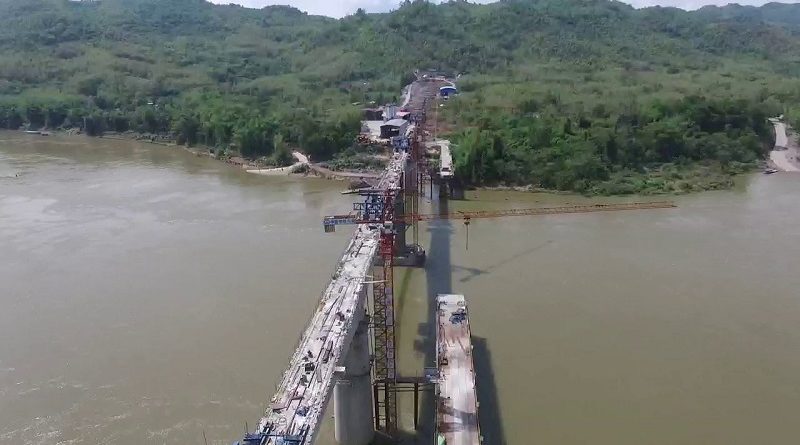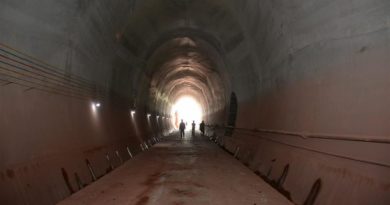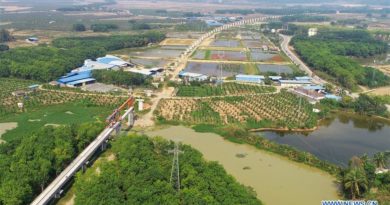China-Laos Railway Marred By Compensation Issues And Pollution
Source: Asean Today
On a wide stretch of the Mekong River flanked by thick forest, just north of Luang Prabang, Laos, a team of Chinese engineers and construction workers recently completed a bridge for the new China-Laos railway.
For months, local residents watched a series of concrete columns rise from an otherwise remote section of the river: first, a temporary scaffolding bridge reached out across the water, then cranes went up, slowly lifting the pieces into place.
The new US$6 billion railway stretches 420 kilometres across mountains and river basins, from the capital at Vientiane to the Mohan-Boten border gate in northern Laos. Project plans say trains will reach 160 kilometres per hour, reducing what has been a two-day journey by road to just three hours.
The railway is the cornerstone of China’s Belt and Road Initiative (BRI) in Laos and has even spawned a pop song by famous Lao singer Sack. China Railway Group has been carrying out construction since December 2016 and the Lao government expects it to be finished by 2021.
Lao President Bounnhang Vorachith has given the BRI his full support, saying he believes it will transform the Laotian infrastructure and improve the county’s quality of life by driving economic development.
The new railway has pushed local residents off of land, leaving them with few options
Bridges and tunnels will account for almost two-thirds of the railway’s length. So far, 47 of 167 bridges and 53 of 72 tunnels have been completed. The bridge near Luang Prabang is the first of two bridges over the Mekong.
But construction has displaced local communities, leaving them with no means of supporting themselves. The government has requisitioned 3,832 hectares of land for the project. The project includes 32 railway stations, some of which, like the one at Vang Vieng, reportedly include land for commercial complexes and hotels.
“Now after resettlement we have no income and it’s been so difficult. We have to pay for food and every other necessity,” said a resident of Luang Pabang province.
Residents displaced by the railway were promised compensation from the Lao government but many of them haven’t received anything. There’s no talk of the Chinese government or the China Railway Group helping out with compensation.
Out of 4,411 families negatively affected by the project, only about 230 of them have been compensated. For many families, the compensation amount hasn’t been set but their land has already been given away.
In the case of one young pineapple farmer named Khalom, from Luang Prabang province, he and his wife lost their land to the railway. Soon, they had to leave their families behind, including Khalom’s sick mother and his three siblings, to search for jobs. They eventually came to Bangkok for work, where they have yet to receive compensation from the Lao government.
“We had to come to Thailand because we don’t have any land to farm and don’t have any other source of income,” Khalom said.
According to Lao Decree 84, issued in April 2016, anyone displaced by a development project in the country has a right to be compensated for their lost income, property, crops, and plants.

A government official involved in the compensation process told Radio Free Asia that the payments will be completed by the end of 2020. But the vice minister at the Lao Ministry of Public Works and Transport, Rattanamany Khounnivong, has said that the government has already spent the money it set aside for compensation – about US$156 million. Khounnivong said the government will have to borrow another US$150 million from China in order to finish the compensation process.
One district-level official near Vientiane has said that the district government was told by superiors to wait before distributing any compensation. Even for those directly involved in delivering compensation, there is little transparency around the process.
The costs weigh heavily as Laotians struggle to see benefits
Plans for the railway construction said that 7,000 Laotians would be hired but so far, only 2,000 are employed, along with 19,000 Chinese. The workers primarily live in purpose-built work camps far from Lao cities and towns and are supplied by Chinese contractors.
According to Chinese state-run news agency Xinhua however, the project is helping Lao workers to develop advanced trade skills.
But it seems that so far, local residents have yet to see many benefits from the project. Professor Philip Alston, United Nations Special Rapporteur on extreme poverty and human rights, summed up this disconnect after his visit to Laos earlier this year: “The Government’s single-minded focus on large infrastructure projects (such as dams and railways), land acquisition, resource extraction, and foreign investment has created all too few jobs for Lao people, generated very large debt repayment obligations, and disproportionately benefited wealthy elites. Those living in poverty, ethnic minorities, and people in rural areas have seen very few of the benefits of the economic boom.”
In some cases, local residents near the railway who retained their land are seeing negative impacts.
In Vang Vieng, local communities noticed a black liquid in the Xong River late last year and traced it back to the polluted runoff from a tunnel construction site. Locals protested the pollution and officials declared that the waste must be diverted from the Xong.
The railway terminus outside Vientiane is located on That Luang Marsh. The biodiverse wetland was declared a special economic zone in 2017 and has since been the site of relentless construction.
There are also concerns about how construction projects in undeveloped areas can impact elephants. Some advocates have said Laos’ dwindling wild elephant population won’t survive the habitat fragmentation caused by the construction.
Debt continues to siphon economic gains away from Laos
The project is being built by the Laos China Railway Company, a joint venture in which China owns a 70% stake and Laos owns 30%. The project costs US$6 billion in total, over one-third of Laos’ US$17 billion gross domestic product (GDP).
Laos has agreed to pay US$720 million within the next five years but to fulfil that promise, will borrow US$470 million from the Export Import Bank of China at 2.3% interest. Laos has yet to figure out how it will fund the remaining US$1.1 billion of its project share. The Lao government may be planning to raise the capital through land concessions.
In 2018, Laos’ public debt was 65% of its GDP and the government is already struggling to generate revenue: taxes account for only 12% of the GDP and the country’s copper and silver mines may be nearing exhaustion.
China Railway Group will soon finish the second bridge across the Mekong, at Ban Ladhan. There are also agreements underway for a Vientiane-Vung Ang railway, from the Lao capital to the Vietnamese port city, and an Ubon Ratchathani-Pakse railway, from Thailand’s northeastern Isaan region into the south of Laos.
At the end of May, just outside Vientiane, construction workers laid the last beam for the Nam Khone super major bridge. It’s the longest bridge along the railway and in the country.
During the final week of construction on the bridge, students from the China-Laos Friendship Nongping Primary School visited the Nam Khone bridge site and the China-Laos Railway Exhibition Hall, a museum space dedicated to raising public awareness of the project.
There, the students watched a documentary about a Laotian labourer from an area in Attapeu province affected by the dam collapse last July who is now working on the railway. The documentary claimed that the case illustrates the potential benefits of the project for Lao people.
But this worker left his home—a post-disaster zone where residents still haven’t received adequate compensation for negligent construction—and came work on a construction project that’s pushing communities off their land, again, without proper compensation.





